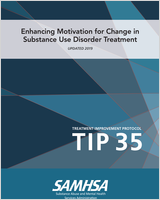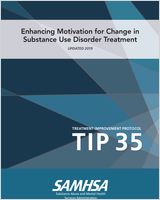NCBI Bookshelf. A service of the National Library of Medicine, National Institutes of Health.
This publication is provided for historical reference only and the information may be out of date.
This TIP, Enhancing Motivation for Change in Substance Abuse Treatment, embraces a fundamentally different way to conceptualize motivation. In this approach, motivation is viewed as a dynamic and changeable state rather than a static trait. This TIP shows how clinicians can influence this change process by developing a therapeutic relationship, one that respects and builds on the client's autonomy and, at the same time, makes the treatment counselor a participant in the change process. The TIP also describes different motivational interventions that can be used at all stages of change, from precontemplation and preparation to action and maintenance. The goal of this TIP is to make readers aware of the research, results, and promise of motivational interventions in the hope that they will be used more widely in clinical practice and treatment programs across the United States.
Contents
- What Is a TIP?
- Editorial Advisory Board
- Consensus Panel
- Foreword
- Executive Summary and Recommendations
- Chapter 1-- Conceptualizing Motivation And Change
- Chapter 2—Motivation and Intervention
- Chapter 3—Motivational Interviewing as a Counseling Style
- Chapter 4—From Precontemplation to Contemplation: Building Readiness
- Chapter 5—From Contemplation to Preparation: Increasing Commitment
- Chapter 6—From Preparation to Action: Getting Started
- Chapter 7—From Action to Maintenance: Stabilizing Change
- Chapter 8—Measuring Components of Client Motivation
- Chapter 9—Integrating Motivational Approaches Into Treatment Programs
- Chapter 10—Directions for Future Research
- Appendix A -- Bibliography
- Appendix B—Screening and Assessment Instruments
- Appendix C—Ordering Information for Assessment Instruments
- Appendix D—Resource Panel
- Appendix E --Field Reviewers
The opinions expressed herein are the views of the Consensus Panel members and do not reflect the official position of CSAT, SAMHSA, or the U.S. Department of Health and Human Services (DHHS). No official support or endorsement of CSAT, SAMHSA, or DHHS for these opinions or for particular instruments or software that may be described in this document is intended or should be inferred. The guidelines proffered in this document should not be considered as substitutes for individualized client care and treatment decisions.
- [The application of motivational interviewing in nursing practice].[Hu Li Za Zhi. 2009][The application of motivational interviewing in nursing practice].Wu CC, Lin CC. Hu Li Za Zhi. 2009 Apr; 56(2):89-93.
- Review Brief Interventions and Brief Therapies for Substance Abuse[ 1999]Review Brief Interventions and Brief Therapies for Substance AbuseCenter for Substance Abuse Treatment. 1999
- [Integrated treatment for severe mental illness and substance abuse: Effective components of programs for persons with co-occurring disorders.].[Sante Ment Que. 2001][Integrated treatment for severe mental illness and substance abuse: Effective components of programs for persons with co-occurring disorders.].Mueser KT, Noordsy DL, Drake RE, Fox L. Sante Ment Que. 2001; 26(2):22-46.
- [Motivational interviewing for cannabis users with psychotic disorders].[Encephale. 2007][Motivational interviewing for cannabis users with psychotic disorders].Bonsack C, Montagrin Y, Favrod J, Gibellini S, Conus P. Encephale. 2007 Oct; 33(5):819-26.
- Review Motivational interviewing.[Annu Rev Clin Psychol. 2005]Review Motivational interviewing.Hettema J, Steele J, Miller WR. Annu Rev Clin Psychol. 2005; 1:91-111.
- Enhancing Motivation for Change in Substance Abuse TreatmentEnhancing Motivation for Change in Substance Abuse Treatment
Your browsing activity is empty.
Activity recording is turned off.
See more...

